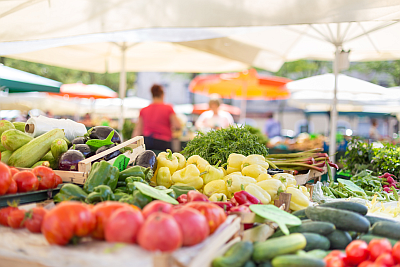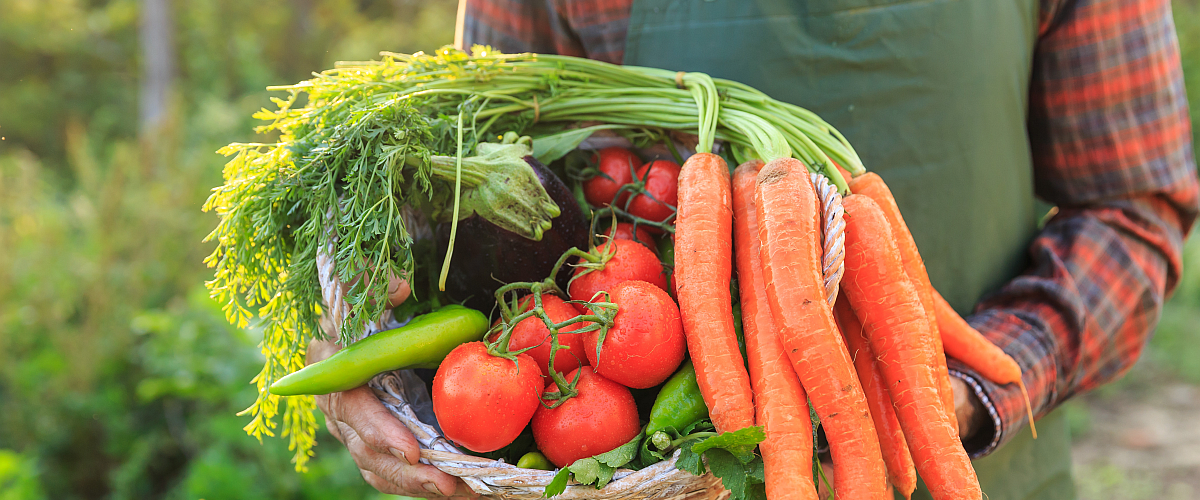Locally grown, locally sourced, local ingredients. The word “local” is popping up more and more, from the aisles of your neighborhood grocery store to the menus at five-star restaurants.
Far from a passing foodie trend, the practice of choosing local food (over items that have been shipped across the country or even the world) has plenty of staying power. When you eat local, you help support your area economy and do the environment a favor, too.
While many foods can be produced in a given area—from honey to meat and dairy—local most often describes fruits and veggies. Aramark used nearly 12 million pounds of local produce in 2018 alone!
Local ingredients can be a big source of culinary creativity. We spoke with three Aramark chefs to learn how regional offerings influence their menus–and how you can follow their lead at home.
CHEF INSPIRATION TO TAKE HOME

Chef Jason Forrest: “Be flexible”
Chef Jason Forrest, who works with colleges and universities in the East region of the U.S., recommends paying special attention to what’s available at that particular time of year. “The variety of produce may be more limited, but those local fruits and vegetables have exquisite flavor that can only come from freshness,” he says.
Seasonal local produce can become the centerpiece of your meal. “Here in North Carolina, blueberries and strawberries are being picked right now,” Chef Jason tells us in May. “We love to use them in salads. One of my favorites is arugula, which is also in season. Top it with blueberries, toasted almonds, and goat cheese and finish with a drizzle of balsamic vinegar.”
If you’re stuck on what to do with a particular food, browse our FYP365 recipe page for tons of chef-tested ideas.

Chef Wayne Hoekstra: “Get out of your comfort zone”
When you’re responsible for feeding the K-12 crowd, as Chef Wayne Hoekstra does across the U.S., keeping the menu interesting is a must. Local foods offer the perfect canvas.
“There are so many playful ways to incorporate local flavors into your meals,” he says. “Whether you’re a fan of savory or sweet, the bright flavor of local produce and in-season herbs will help expand your palate.”
Chef Wayne suggests hitting your local market at least weekly to sample new produce as soon as it comes into season. “Growers have become more diverse alongside their communities, so you’re bound to discover something you haven’t tried before. Heirlooms, or old-time varieties, have especially gained popularity.”
If you haven’t exercised your green thumb in a while (or ever!), try growing your own garden. The tomatoes you plant now will be ready come summer, and colorful root veggies like carrots and beets will be ready in the fall.

Chef Tom Rossiter: “Experiment with new techniques”
So you’ve brought home the freshest array of fruits and veggies. Now what? “Think about the many ways to prepare them, from pickling to throwing them on the grill,” says Executive Chef Tom Rossiter, who prepares dishes from local Mid-Atlantic ingredients for employees who’ve come to appreciate his passion for bringing local flavors to their workplace cafe.
Take the humble tomato and onion, for example. “They not only have incredible flavor right off the grill, but they also shine in sauces and preserves,” he attests.
Your farmers’ market is the perfect place to get ideas. “New places mean new people! I love to discuss food with others to learn fresh techniques. Go ahead and ask the vendor, ‘What can I do with this?’ They’re going to be more than happy to share with you,” Chef Tom encourages.
MORE TIPS FOR GOING LOCAL
Our chefs have many ideas for shaking things up at home with local produce. Here are some next steps to get the local produce ball rolling:

- Find your local farmers’ market. Spring, summer, or fall, there’s usually a farmers’ market or farm stand within easy reach! While you’re exploring, take time to get to know your area farmers. “Their passion and knowledge are amazing, and your purchase helps support the local economy,” says Chef Jason. Search for your nearest market here.
- Look at labels. At the grocery store, pay attention to labels that tell you a food is locally grown. Ask your grocer questions just as you would at the farmers market. They can point you to locally sourced options, too. These choices are not only great for your table; they can reduce your consumer carbon impact by minimizing shipping and distribution miles.
- Join a CSA. With community-supported agriculture (CSA), you sign up to buy local produce from a farmer for an entire growing season, typically on a weekly basis. “These groups are another great way to support local farmers, enrich your community, and enjoy quality produce–which may even be delivered straight to your door,” explains Chef Tom.
- Plant a garden. Cultivating a garden can not only give you the herbs and produce you’re looking for, but also be a fun family project! “Lettuce, radishes, strawberries, and herbs all grow quickly and can help prime kids’ interest,” Chef Wayne advises. “And don’t forget the flowers–there is nothing like adding your own bouquet to the dining table.”
An adventure awaits when you start thinking local and buying and cooking more local produce. Now that warm weather is here, the options are better than ever. Savor what’s in season–and show off that hometown or home state pride!
Note: Since everyone’s health history and nutritional needs are so different, please make sure that you talk with your doctor and a registered dietitian to get advice about the diet and exercise plan that‘s right for you.

